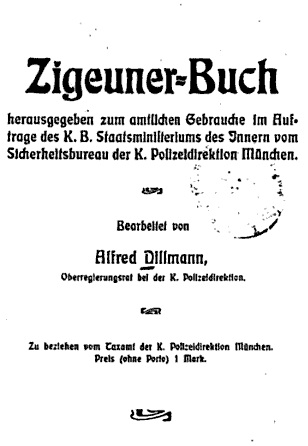

The "Zigeuner-Zentrale" ["Gypsy Headquarters"] in Munich had been building up a card index of individuals since 1899 which contained personal data and all kinds of details, such as the number of accompanying animals and destinations. The "Gypsy Book" contained profiles on 3,350 people. 7,000 copies of the book were distributed to police stations within and outside of Bavaria. The data collected was gradually extended.
The National Socialists thus had access to already available material, including fingerprints and photos. They now drew up thousands of so-called genealogical charts: family trees, which listed not only family relationships but also illnesses and wrongdoing relating to individual family members. Such genealogical charts proved to be life-threatening documents in the course of persecution.
Extract from the Bavarian "Law to Combat Gypsies, Vagrants, and the Work-Shy" of 16 July 1926
[…]
Article 5
Gypsies and vagrants may not travel or rest in hordes. A horde shall be considered to be an association of several individuals or several families, as well as an association of individuals with a family of which they are not members. A group of persons living together as if they were a family shall also be considered as a horde.
Article 6
Gypsies and vagrants may only camp in the open and set up their caravans and carts in places where local police authorities have instructed them to do so, and only for the time period set by local police authorities. […]
[…]
The choice of the word "horde" or "gang" (German: Bande) , which was also used in the "Zigeuner-Buch" shows what it was: the identification of people who were persecuted as "Gypsy" with criminals.
Extract from the ministerial resolution on the implementation of the Law to Combat Gypsies, Vagrants, and the Work-Shy in Bavaria of 16 July 1926
"[…] Definition. The term 'gypsy' is generally known and needs no more precise explanation. The study of race provides information on who should be considered a gypsy. ‘Vagrants’ should be understood as persons who may not be counted as gypsies in racial or tribal terms, but whose nomadic lifestyle is equivalent to that of the gypsies. The essential characteristic of the vagrant is that he, like the gypsy, roams around with his personal effects and, as the case may be, with his family, giving up any permanent relationship with any real or fictional domicile that might exist. […]"
Karl Stojka (born 1931) describes his childhood in Austria and his family who had been travelling the country as horse dealers for generations:
 "We are Roma, that is, gypsies – there are also Sinti, that is another tribe, but we Roma are in Austria with caravans, horses, which we hitched up and my father did actually roam around, back then, along with many other gypsies and Roma and Sinti.
"We are Roma, that is, gypsies – there are also Sinti, that is another tribe, but we Roma are in Austria with caravans, horses, which we hitched up and my father did actually roam around, back then, along with many other gypsies and Roma and Sinti.
My father was also born in Graz and his father was born in Graz too. So in our family, we have lived in Austria for over three hundred years. Back then we roamed around, so that means from Vienna to Wiener Neustadt, from St. Pölten, heading for Graz or heading for Salzburg. And that was when autumn was ending, so by October, November, we were always based in Vienna or in a village or in a town.
But we had a house in Vienna and a large courtyard and we moved in there November, December, January, February … And when March came, that meant for the Roma …, well, hitch up, we’re going on our travels again, to live again and earn money. In 1931, 32, 33, then my father was a horse dealer. The farmers he travelled to – Lower Austria, Upper Austria or anywhere else – the farmers had been waiting for him because he had always had good horses. And my mother went selling from door to door. She always had curtains, wooden spoons and knives etc. Then sometimes she read palms and told people all kinds of nonsense. And they gave her something for it."
